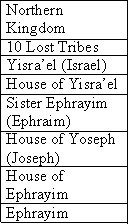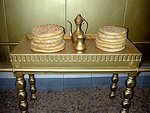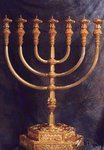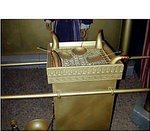Let’s take each of the Feasts one by one. First Yom Teruah: On the 1st day of the 7th month, Yahweh commanded us to keep the Feast of Trumpets. The Feast of Trumpets is mentioned in the following verses:
 Leviticus 23:24 - Speak unto the children of Yisra’el saying, In the seventh month, on the first day of the month, you shall have a rest, a remembrance of blowing of trumpets, a set-apart gathering.
Leviticus 23:24 - Speak unto the children of Yisra’el saying, In the seventh month, on the first day of the month, you shall have a rest, a remembrance of blowing of trumpets, a set-apart gathering.Numbers 29:1 - And in the seventh month, on the first day of the month, you have a set-apart gathering, you do no servile work, it is a day of blowing the trumpets for you.
This day is to be observed as a Sabbath day. It is a time of shouting, blowing trumpets and rejoicing. The Hebrew name for this day is "Yom Teruah" which literally means "Day of Alarm or Day of Sounding".
A Shofar (pronounced Show-far or Show-fur) is perhaps the oldest wind instrument known to man. Made of the hollowed horn of an animal, usually a ram, it is blown on Yom Teruah. It is blown on Yom Teruah to inaugurate Moshiach as King of the Universe, and on Yom Kippur to cap off the day as it surmounts its spiritual peak.
Because of its powerful, thundering voice, a shofar was sounded at events of earth-shattering significance. A surround-sound shofar blast filled the atmosphere when the Torah was given at Mt. Sinai, Joshua conquered Jericho with seven assault-shofar city circlings, Jewish kings were inaugurated to the sound of the Shofar, and the greatest shofar recital in all eternity will accompany the arrival of Moshiach, Yahshua!
The blowing of the shofar on Yom Teruah consists of four sounds sounded in a specific order: tekiah (t-KEE-uh), shvarim (sh-VAW-reem) teruah (t-ROO-uh) and tekiah gedolah (geh-DOH-luh). Each lasts approximately three seconds except tekiah gedolah. Tekiah is a straight, unbroken blast, shevarim is a tekiah broken into three one-second segments, teruah is a staccato division of the tekiah into nine rapid-fire notes, while tekiah gedolah is a triple tekiah, lasting a minimum of three consecutive tekiot, or nine seconds. A tekiah gedolah replaces the final tekiah in the set blown. Tekiah “Blast”, Shevarim “Broken”, Teruah “Alarm”, Tekiah Gedolah “The Great Tekiah” or “The Great Blast”.
Are you making the connection? Many believe that this feast is symbolic of Yahushua's return, and our own advancement toward the promised land (Yahweh's kingdom) at Yahushua's return. Remember that scripture says Yahushua will return at the 'last trump':
1Corinthians 15:51-52 “See, I speak a secret to you: We shall not all sleep, but we shall all be changed, in a moment, in the twinkling of an eye, at the last trumpet. For the trumpet shall sound, and the dead shall be raised incorruptible, and we shall be changed.
When that Tekiah Gedolah, “The Great Tekiah” or “The Great Blast” sounds it will announce the return of Yahushua!
Yom Kippur: After Yom Teruah there are what’s called the 10 days of Awe. It is a time to reflect on your life and to make Teshuvah or repentance. Yom Kippur is the Day of Atonement. It is not a day of feasting. Rather, it is a day of fasting. It is a high Sabbath:

Leviticus 23:27-28 “On the tenth day of this seventh month is the Day of Atonement. It shall be a set-apart gathering for you. And you shall afflict your beings, and shall bring an offering made by fire to Yahweh. “And you do no work on that same day, for it is the Day of Atonement, to make atonement for you before Yahweh your Elohim.”
“Afflict your beings” has nothing to do with cutting yourself or crawling on your knees for miles. It just means to fast. The focal point of this feast involved the high priest entering the holy of holies. However, before entering, he had to first bathe his entire body, thus going way beyond the mere washing of hands and feet which were required for other occasions. This washing symbolized the high priest's desire for purification. Rather than wearing his usual robe and colorful garments (Exodus 28 and Leviticus 8), he was commanded to wear special garments of linen. The high priest sacrificed a bullock as a sin offering for himself and for his house (Leviticus 16:6). After filling his censer with live coals from the altar, he entered the holy of holies where he placed incense on the coals. Next, he took some of the blood which was taken from the slain bullock and sprinkled it on the mercy seat of the Ark of the Covenant (Leviticus 16:13) and also on the ground in front of the mercy seat, providing atonement for the priesthood (Leviticus 16:14-15). Then he sacrificed a male goat as a sin offering for the people. Some of this blood was then also taken into the most set-apart place and sprinkled there on behalf of the people (Leviticus 16:11-15).
Next, the high priest took another goat (called the "scapegoat"), laid his hands on its head, confessed over it the sins of Israel, and then released it into the desert where it symbolically carried away the sins of the people (Leviticus 16:8,10). The remains of the sacrificial bullock and male goat were taken outside of the city and subsequently burned. Some believe that Yom Kippur is symbolic of when Yahushua will completely destroy the last enemy (death) at the end of the 1000 year reign when Satan will finally be thrown into the lake of fire. Then all sin will be atoned for and those who have chosen righteousness will forever be with Yahweh. On Yom Kippur, the Book of Life is sealed.
Sukkot: Now let's look at the Feast of Tabernacles. It is 5 days after Yom Kippur.
Leviticus 23:34 - “Speak to the children of Yisra’el, saying, ‘On the fifteenth day of this seventh month is the Festival of Booths for seven days to Yahweh. On the first day is a set-apart gathering, you do no servile work.
‘For seven days you bring an offering made by fire to Yahweh. On the eighth day there shall be a set-apart gathering for you, and you shall bring an offering made by fire to Yahweh. It is a closing festival, you do no servile work.

Sukkot means "booths, tabernacles". All of Israel is commanded to dwell in booths during the 7 days of the feast. This is the first and eighth day mentioned in the above verses. The last day is also known as the "Last Great Day". The first and eighth days are Sabbaths and holy convocations. At this feast, it is good to build a "Sukkah" or temporary dwelling place made with surrounding trees and branches.
It is a time to remember how temporary this life really is and to consider that one day we will tabernacle with Yahweh forever:
Revelation 21:3 - And I heard a loud voice from heaven saying, "Behold, the tabernacle of Yahweh is with men, and He will dwell with them, and they shall be His people. Yahweh Himself will be with them and be their Elohim.
This year, according to the Biblical reckoning of time, Yom Kippur will fall on Tuesday, Oct. 3rd at sundown until Wednesday, Oct. 4th at sundown. Most of the Jews follow the Rabbinic calendar which made Yom Kippur last Sunday-Monday. However in a future article I will explain why I do not follow the Rabbinic calendar. According to the Biblical reckoning of time Sukkot begins on Sunday, Oct. 8th at sundown. The first day is a Sabbath.
 The eight day, or Shemini Azaret will fall on Oct. 16th at sundown and end on the 17th sundown and is also a Sabbath.
The eight day, or Shemini Azaret will fall on Oct. 16th at sundown and end on the 17th sundown and is also a Sabbath.My family will be joining our congregation, and others from all over (some are coming from Canada) at the coast for a 10 day camping trip. We will dwell in tents, yurts, RVs, etc, spend the week studying Scripture, worshipping, playing, visiting, eating, making crafts, sitting around the campfire, etc. It is a joyous time and a time to fellowship with our brothers and sisters in Yahshua. This year we are going to review all of the prophets and prophecies and see how they correlate concerning the coming of Yahshua and the Millennial Reign. It should be an interesting and exciting study.
Let’s look at the Fall Feasts another way, Yom Teruah, Day of Blasts, announces the coming of the Bridegroom. Yom Kippur, Day of Atonement, is the marriage to the Bride, and Sukkot, Feasts of Tabernacles, is the celebration or Marriage Supper of the Lamb!
Rev 19:7 “Let us be glad and rejoice and give Him praise, for the marriage of the Lamb has come, and His wife prepared herself.” And to her it was given to be dressed in fine linen, clean and bright, for the fine linen is the righteousnesses of the set-apart ones. And he said to me, “Write, ‘Blessed are those who have been called to the marriage supper of the Lamb!’ ” And he said to me, “These are the true words of Elohim.”
 We are to keep the Feasts of Yahweh the best we can because first, He commanded us to, and secondly because they are rehearsals of things to come. If we don’t practice now, we will be caught unprepared.
We are to keep the Feasts of Yahweh the best we can because first, He commanded us to, and secondly because they are rehearsals of things to come. If we don’t practice now, we will be caught unprepared.Blessings to you on these Sabbaths and Feasts of Yahweh. Whether you are following the Rabbinic calendar or the Biblical calendar I pray that His Feasts will become more and more meaningful to you everyday. With much love.














